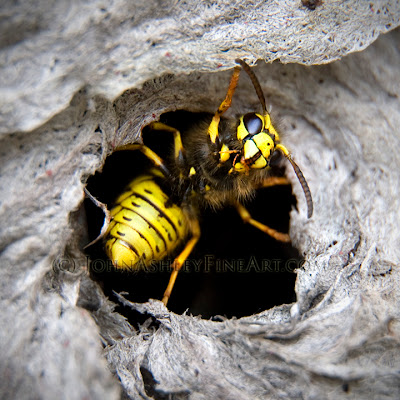 |
| Western yellowjacket at opening to paper nest |
Confused yet?
Wasps, bees and ants are all closely-related insects in the order, hymenoptera (“membrane wing”). The oldest of these insects first appeared during the Triassic Period, more than 200 million years ago. Today, entomologists have classified only about 125,000 wasp species out of an estimated 600,000 to 1,200,000 world-wide. The majority of the identified wasps (more than 100,000 species) benefit us because they are parasitic – the adult or young wasps eat other insects. Some adults also eat nectar, fruit and tree sap.
Wasp species can also be described as either solitary or social. Solitary wasps live and forage alone, and they do not build nests. Social wasps live together in a distinct caste system, in paper nests that might house many thousands of workers and one queen.
 |
| Bald-faced hornets guarding area around the nest. Click to see the three primitive ocelli eyes on top of their heads. |
In the spring (late-April or May) young queens emerge from their overwintering sites that are often underground, or sometimes in logs or woody debris. Each queen begins her colony by starting a small paper nest in a tree, attic, or under a roof eve. She builds 20-50 hexagon-shaped cells under a small umbrella-shaped top. She’ll lay a fertilized egg in each cell, which grows into a legless grub and pupates into an unfertile female worker wasp in 2-3 weeks (the timing depends on weather and temperature).
As the female worker wasps emerge, they take over the tasks of enlarging the nest, foraging for food, feeding the young and the queen, and defending the colony. From here on, the founding queen will never leave her nest again.
 |
| Female worker yellowjacket adding new paper layer to outside of nest |
The nest grows larger as the workers redesign the nest into a football-like shape, and the queen lays more eggs. The female workers create new nest layers from chewed-up wood, cardboard or paper. They add a starch from their saliva and use their mandibles to form the wet pulp into thin layers of paper. As the family grows, the workers add horizontal layers of egg chambers. Paper from the early shell is removed from the interior layers and recycled into new layers.
The female workers also leave the nest to forage for insects, which they’ll chew up to bring back and feed to the young, worm-like larvae and the inactive pupae. In return, the young secrete a sweet sort of nectar that the workers relish (an exchange known as “trophallaxis”).
In late summer, the outnumbered larvae don’t produce enough nectar for all of the adult workers. So the foraging females’ food preference changes from insects to fruit -- or to scavenging human food, sodas, etc. This is when wasps (yellowjackets and hornets) tend show up as uninvited guests at your picnic, seeking sweet items like your iced tea or those watermelon slices (or Bud Light with lime, so I'm told).
In late summer or early fall, the aging queen begins laying unfertilized eggs that grow into fertile male “drones” and fertile females, neither of which have stingers. These “reproductives” remain in the nest and are fed by the workers until they’re ready to mate. Males fly off in search of distant, unrelated females.
Fertile females that successfully mate near their home nest will now rely on their fat reserves to overwinter as “new queens.” Each new queen might have mated with several males, storing the sperm in tight packets inside her abdomen where it remains dormant all winter. She’ll use it next spring to start the whole cycle anew.
 |
| Cross-section of abandoned bald-faced hornet nest showing three egg cell layers, multiple nest layers, and nest opening |
Wasps sting to kill the insects that they eat, but some wasp species also use their stingers to aggressively defend the nest vicinity – especially our bald-faced hornets. Bald-faced hornet stings contain a neurotransmitter, acetylcholine, which is more effective at stimulating pain nerves than typical wasp venoms.
Only the female workers have stingers. Wasp stingers aren’t barbed, like those of bees, so they can inject their stingers repeatedly. The sting of many wasp species also leaves a chemical marker that identifies you as an enemy of the state, which directs a stinging swarm to you unless you leave the area immediately, giving rise to the phrase, “mad as a hornet.”
If you do get stung, it probably won’t matter if you’re still confused between hornets and yellowjackets. Either way, you’ll probably come up with a few more “choice” names for our native wasps.
Behind the bugs: There's no good time to photograph well-armed wasps, but they're somewhat sluggish early in the morning and late in fall, when they're colder. Also, thanks to my friend Jim for gently slicing the hornet nest in two on what had been a very clean and expensive bandsaw.

